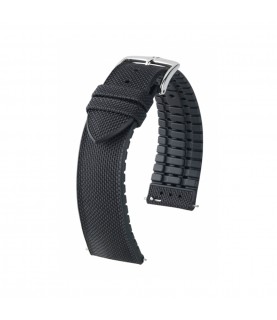The Lightness Of Breaking Records

Bulgari has already broken several horological thinness records at Baselworld, and the Italian brand didn’t plan to make an exception this year. After the launch of the world’s thinnest tourbillon movement at Baselworld in 2014 (thanks to a 1.95-mm thin, hand-wound movement in a 5-mm case), the introduction of the thinnest minute repeater in 2016 (with a 3.12-mm-thin movement in a 6.85-mm case) and the thinnest self-winding watch, at only 5.15 mm in 2017, Bulgari has now managed to break several records at the same time. At just 3.95 mm thick, the new Octo Finissimo Tourbillon Automatic is not only the thinnest tourbillon watch, but also reclaims the title as the thinnest serially produced automatic watch from Piaget (last December, Piaget became the record holder for the world’s thinnest serially produced automatic watch, coming in at only 4.3 mm thick). Bulgari based the overall construction of the movement on the Finissimo tourbillon movement launched in 2014.

The new in-house Caliber BVL 288 handles automatic winding not via a micro-rotor (like the Octo Automatic), but via a peripheral oscillating weight positioned on the back of the movement. It is made of white gold and aluminum, two metals whose contrasting densities (16.4 grams versus 2.70 grams per cm³) should enable the circular weight to oscillate more efficiently. The new movement also incorporates a flying tourbillon equipped with a ballbearing system to contribute to the reduced thickness. Measuring just 1.95 mm thick and offering a 52-hour power reserve, Caliber BVL 288 is housed in a sandblasted 42-mm titanium case (which is 2 mm larger in diameter than the previous Minute Repeater, the Automatic and the Tourbillon, due to the added oscillating weight). The movement is partially visible through an opening on the caseback in the shape of the entrance of the boutique on the Via Condotti in Rome. The watch is limited to 50 pieces (with the individual number engraved on the crown); price is $118,000.

Another record-breaking introduction comes in the form of Bulgari’s Octo Finissimo Minute Repeater Carbon. The thinnest minute repeater in the world has now also become the lightest. Thanks to the use of Carbon Thin Ply (CTP) for the dial, case and bracelet, the watch weighs only 47 grams and transmits sound even better than its predecessor. The case dimensions are identical to the titanium version of 2016: 40 mm in diameter and 6.85 mm thin. The manual movement is in-house repeating Caliber BVL 362 with a 42-hour power reserve. The watch is limited to 50 pieces and is priced at $160,000. WatchTime talked with Guido Terreni, Bulgari Watches Managing Director, about the two record-breaking watches launched at Baselworld.

WT: Can you tell us more about the Octo Finissimo Automatic? GT:This is our fourth record breaker. It is the thinnest automatic watch in the world, and – by the way – it is a tourbillon. How did we manage to do this? First of all, we have the [flying tourbillon] cage with the ball-bearing system, which is the same that we used for the manual version, that gives the height of 1.95mm. We added the peripheral oscillation mass, which is wider than the movement. That’s why the case is [2 mm] bigger. Then to be able to be so thin in the case and to have the oscillating mass that is moving freely, we had to isolate the crown, because a normal crown would have needed a thicker movement, because the peripheral oscillating would have to be lower. So what did we do? We have this push button (at 4 o’clock) that allows you to change the function of the crown from time setting to winding. You press this button and you set the time. Then you press it again and wind the watch, because you have a transmission of wheels that activate the hands on one side, and when you push the button, the wheels activate the barrel.

WT: How long did it take to build a watch like that? GT:The movement development took three years; the case was quicker because we already had the experience. To get to the 3.95 mm of the case, we had to abandon a fully transparent caseback. Titanium is sturdier than gold. A gold case could have been too soft, and if you press, you could affect the movement. That’s the reason why we have an opening (on the caseback) at 6 o’clock, to see the tourbillon and the peripheral oscillating mass, which has the Bulgari logo, when it’s at 6 o’clock.It would have been thicker with a crystal [on the caseback]. We keep the 0.7 mm of the sapphire on the top. We had to re-do the crown, because this [existing] crown was gigantic on this watch, so we had to re-proportion the crown.

WT: What about the Octo Finissimo Minute Repeater Carbon? GT: Again, aesthetic choices drive everything. We wanted a black watch, and we wanted it from nature. So carbon gives you black, and it’s not injected in a mold, it is really solid carbon, which is done with layers. So you have these thin lines, one layer atop the other, even in the bezel. The dial is also in carbon and it gives you this camouflage effect, because that is how the material is in real life, and we did the bracelet [in carbon too]. To my recall, I don't remember a bracelet in carbon done by anyone. This has to be done link by link, it cannot be done with a normal technique as you would do with metal. So, aesthetics drive everything, but aesthetics have to be useful, technically speaking, because carbon chimes [even] better than titanium. It is 8 percent more powerful. And then the weight: this watch in titanum would be 77 grams; this is only 47.





